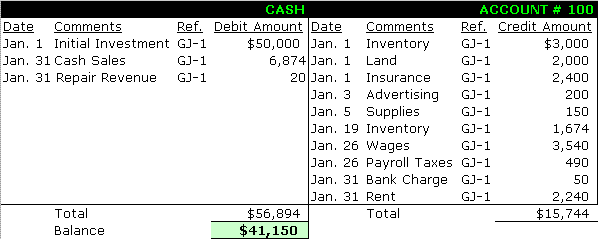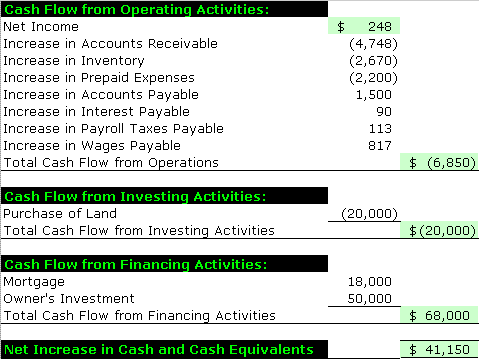Preparing the Statement of Cash Flows
| The cash flow statement summarizes the cash inflows and outflows at the end of the accounting cycle, in this case the month of January. |
For a complete discussion of the purpose and use of the cash flow statement, along with an in depth illustration, click cash flow statement.
During the accounting cycle, all of the accounting entries affecting the cash balance were posted to the general ledger. The cash account provides us with the ending cash balance at the end of January.
Sunny Sunglasses Shop posted the following transactions to the cash general ledger account for January as illustrated below:
The cash balance in the general ledger account equals $41,150. Since accountants produce the balance sheet from the same general ledger accounts using the adjusted trial balance, this same cash balance appears on the balance sheet for January.
Statement of Cash Flows
The cash flow statement is produced from both the income statement and the balance sheet. Starting with net income from the January earnings statement of $248, the cash flow statement shows each cash inflow and outflow for January that resulted in the final cash balance for January on the balance sheet.
Sunny Sunglasses Shop
Statement of Cash Flows
For the Month Ending
January 31, 2010
The statement of cash flows categorizes each cash inflow and outflow as an operating activity, an investment activity, or a finance activity.
Cash Flow Operating Activities and the Statement of Cash Flows
Operating activities includes cash inflows and outflows necessary for operating the business, such as cash receipts for sales, and cash payments for inventory, rent, and wages.
- Accounts receivable represents sales to customers on account, and not for cash actually received for the sale. Because net income includes this amount in sales and net income, Sunny subtracts this increase in accounts receivable for the year to determine actual cash received. Notice that on the January earnings statement total sales equal $11,680. From the above cash ledger account we can see that cash sales equal $6,874 ($11,680 – 4,806).
- This is the amount of the cash receipts for sales, leaving a balance in accounts receivable for the month of January equal to $4,806 (before bad debts) as listed on the January Balance Sheet. Since bad debts were $58 for January, however, the total increase in accounts receivable was ($4,806 – $58) $4,748. Sunny subtracts any increase in accounts receivable from net income to determine cash sales only.
- The $58 bad debt expense does not represent a cash outlay, and is added back either separately or as net to the increase in receivables as we have done here.
- An increase in inventory represents products purchased for sale, and therefore decreases the cash balance. Since the inventory for the period increased from zero to $2,670, and inventory is not part of the income statement, Sunny subtracts this amount from net income since inventory purchases represent cash paid in operations for inventory. Any amount paid on credit is added back separately (see last step below).
- An increase in prepaid expenses represents what the business paid in cash for an asset for future use. The business expensed only the January portion of the prepaid insurance on the January income statement, leaving a balance of $2,200 in the prepaid expense account. Since the business paid cash for prepaid insurance, Sunny subtracts the balance of $2,200 to prepare the cash flow statement.
- All of the payable accounts represent expenses that reduced net income, for which the business did not use cash. Since accounts payable, interest payable, wages and payroll taxes payable all increased in January, these amounts are added back to net income.
Sunny Sunglasses Shop had a net outlay of cash in the amount of $6,850 for operating activities.
Cash Flow Investing Activities and the Cash Flow Template
The purchase of land represents a cash investing activity during the month of January. Any amount the business used to finance the land is added back in the financing section separately to determine the net cash outlay for the land.
- Sunny purchased land for $20,000, an investing activity.
Cash Flow Financing Activities and the Cash Flow Template
- Instead of paying cash for the land, Sunny financed the land purchase with a mortgage for $18,000. Since the mortgage represents cash received from financing in the amount of $18,000, Sunny adds this amount under financing activities. The cash flow statement shows the net result of cash used to purchase land of $2,000.
- Sunny’s initial investment of $50,000 represents a cash inflow of $50,000 for financing the business.
The net increase to cash equals the increase in the cash balance for the period.
Since Sunny Sunglasses Shop started operations in January, the cash balance at the beginning of the period equaled zero. The net increase equals therefore equals the ending cash balance of $41,150 as shown on the balance sheet.
The Cash Flow Template Bottom Line: Net Change in Cash
| Beginning Cash Balance | + Cash Inflows | – Cash Outflows | = Ending Cash Balance |
| $0 | + $68,000 | – $26,850 | = $41,150 |
Back to the Cash Flow Statement Main Page
Back to the Accounting Cycle and Double Entry Bookkeeping Main Page


